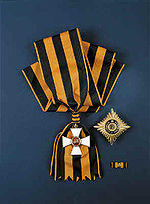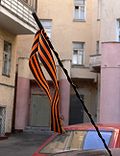
Ribbon of Saint George
Encyclopedia

World War II
World War II, or the Second World War , was a global conflict lasting from 1939 to 1945, involving most of the world's nations—including all of the great powers—eventually forming two opposing military alliances: the Allies and the Axis...
and especially with the units who were awarded the collective Guard
Russian Guards
Guards or Guards units were and are elite military units in Imperial Russia, Soviet Union and the Russian Federation. The tradition goes back to the retinue of a knyaz of medieval Kievan Rus' and the streltsy, the Muscovite harquebusiers formed by Ivan the Terrible by 1550...
battle honours during the conflict. The ribbon consists of a black and orange bicolour pattern, with three black and two orange stripes. Its origins lay back in the times of the Russian Empire.
The Georgian ribbon emerged as part of the Order of St George
Order of St. George
The Military Order of the Holy Great-Martyr and the Triumphant George The Military Order of the Holy Great-Martyr and the Triumphant George The Military Order of the Holy Great-Martyr and the Triumphant George (also known as Order of St. George the Triumphant, Russian: Военный орден Св...
, established in 1769 as the highest military decoration of Imperial Russia (and re-established in 1998 by the Russian Federation
Russia
Russia or , officially known as both Russia and the Russian Federation , is a country in northern Eurasia. It is a federal semi-presidential republic, comprising 83 federal subjects...
). While the Order of St George was normally not a collective award, the ribbon was sometimes granted to regiments and units that performed brilliantly during wartime and constituted an integral part of some collective battle honours (such as banners
Colours, standards and guidons
In military organizations, the practice of carrying colours, standards or Guidons, both to act as a rallying point for troops and to mark the location of the commander, is thought to have originated in Ancient Egypt some 5,000 years ago...
and pennant
Pennon
A pennon was one of the principal three varieties of flags carried during the Middle Ages . Pennoncells and streamers or pendants are considered as minor varieties of this style of flag. The pennon is a flag resembling the guidon in shape, but only half the size...
s). When not awarded the full Order, some distinguished officers were granted ceremonial swords, adorned with the Georgian ribbon. In 1806, distinctive Georgian banners were introduced as a further battle honour awarded to meritorious Guards and Leib Guard
Russian Imperial Guard
The Russian Imperial Guard, officially known as the Leib Guard were military units serving as personal guards of the Emperor of Russia. Peter the Great founded the first such units following the Prussian practice in the 1690s, to replace the politically-motivated Streltsy.- Organization :The final...
regiments. The pike on which these flags were mounted was topped by the St George Cross
St George's Cross
St George's Cross is a red cross on a white background used as a symbolic reference to Saint George. The red cross on white was associated with St George from medieval times....
and adorned with 4,44 cm wide Georgian ribbons. It remained the highest collective military award in the Russian military
Armed Forces of the Russian Federation
The Armed Forces of the Russian Federation are the military services of Russia, established after the break-up of the Soviet Union. On 7 May 1992 Boris Yeltsin signed a decree establishing the Russian Ministry of Defence and placing all Soviet Armed Forces troops on the territory of the RSFSR...
until the Revolution in 1917.

Stavka
Stavka was the term used to refer to a command element of the armed forces from the time of the Kievan Rus′, more formally during the history of Imperial Russia as administrative staff and General Headquarters during late 19th Century Imperial Russian armed forces and those of the Soviet Union...
Verkhovnogo Glavnokomanduyuschego) and by the order No. 308 of the People's Commissar of Defense for the distinguished services during the Yelnya Offensive
Yelnya Offensive
The Soviet Army's Yelnya Offensive operation was part of the Battle of Smolensk during the initial period of the German-Soviet War....
. The 100th, 127th, 153rd and 161st Rifle Divisions were renamed into the 1st, 2nd, 3rd and 4th Guards Divisions, respectively. The units and formations nominated for the Soviet Guard title received special Guards banner in accordance with the decision of the Presidium of the Supreme Soviet
Presidium of the Supreme Soviet
The Presidium of the Supreme Soviet was a Soviet governmental institution – a permanent body of the Supreme Soviets . This body was of the all-Union level , as well as in all Soviet republics and autonomous republics...
of the USSR
Soviet Union
The Soviet Union , officially the Union of Soviet Socialist Republics , was a constitutionally socialist state that existed in Eurasia between 1922 and 1991....
. On 21 May 1942, the Presidium of the Supreme Soviet of the USSR introduced Guards rank
Military rank
Military rank is a system of hierarchical relationships in armed forces or civil institutions organized along military lines. Usually, uniforms denote the bearer's rank by particular insignia affixed to the uniforms...
s and Guards badge
Badge
A badge is a device or fashion accessory, often containing the insignia of an organization, which is presented or displayed to indicate some feat of service, a special accomplishment, a symbol of authority granted by taking an oath , a sign of legitimate employment or student status, or as a simple...
s to be worn of the right side of the chest. Both included the Georgian ribbon pattern. In June 1943, they introduced the Guards Red Banners for the land forces and in February 1944 - for the naval forces. Georgian ribbons adorned the banners exactly as in the 19th century.
This is worn in a manner to celebrate Victory Day
Established on 8 November 1943, the Order of Glory (Orden Slavy) was an order
Order (decoration)
An order or order of merit is a visible honour, awarded by a government, dynastic house or international organization to an individual, usually in recognition of distinguished service to a nation or to humanity. The distinction between orders and decorations is somewhat vague, except that most...
of the Soviet Union. It was awarded to non-commissioned officers and rank-and-file of the armed forces, as well as junior lieutenants of the air force, for bravery in the face of the enemy. The ribbon of the Order was orange with three black stripes - the same as that of the Cross of St. George
Cross of St. George
thumb|Original Cross of St. George.Ist and 2nd class were in gold.The Cross of St. George ', or simply the George's Cross, was, until 1913, officially known as the Sign of Distinction of the Military Order of St. George....
.
One of the most honourable medals in the Soviet Army, For the Victory Over Germany
Medal For the Victory Over Germany
The Medal For The Victory Over Germany In The Great Patriotic War 1941–1945 was one of the most widespread military decorations in the Soviet Union. 14,933,000 people were awarded this medal...
also features St. George stripes. It was awarded to all the soldiers and officers who directly participated in the combat actions during the Eastern Front
Eastern Front (World War II)
The Eastern Front of World War II was a theatre of World War II between the European Axis powers and co-belligerent Finland against the Soviet Union, Poland, and some other Allies which encompassed Northern, Southern and Eastern Europe from 22 June 1941 to 9 May 1945...
campaigns, and was the first award to be universally granted to all the veterans, for the most part, right after the end of the war. This award, along with the similar medal For the Victory Over Japan
Medal For the Victory Over Japan
The medal For the Victory Over Japan was a Soviet military decoration, awarded to all the soldiers, officers and partisans who directly participated in the live combat actions against Japan during the Second World War...
, is still used in the former Soviet Union countries to distinguish between the actual veterans of World War II and all non-combat participants.

Georgievskaya Lenta Action
Since the 60th anniversary of the Victory Day in 2005, the ribbonis freely worn by civilians in Russia as an act of commemoration and remembrance. For the naming of the ribbons the diminutive
Diminutive
In language structure, a diminutive, or diminutive form , is a formation of a word used to convey a slight degree of the root meaning, smallness of the object or quality named, encapsulation, intimacy, or endearment...
form is used: георгиевская ленточка. It has since been distributed in Moscow, all over Russia, and around the world in the preparation for the event and is widely seen on wrists, lapels, and cars.
See also
- Order of St GeorgeOrder of St. GeorgeThe Military Order of the Holy Great-Martyr and the Triumphant George The Military Order of the Holy Great-Martyr and the Triumphant George The Military Order of the Holy Great-Martyr and the Triumphant George (also known as Order of St. George the Triumphant, Russian: Военный орден Св...
- Awards and decorations of the Russian FederationAwards and decorations of the Russian FederationThe award system of the Russian Federation has varied and distinct origins. The first being pre-1917 orders of the Russian Empire re-established after 1991. The second is from former Soviet orders that were slightly modified and kept after the USSR's collapse...
- Russian GuardsRussian GuardsGuards or Guards units were and are elite military units in Imperial Russia, Soviet Union and the Russian Federation. The tradition goes back to the retinue of a knyaz of medieval Kievan Rus' and the streltsy, the Muscovite harquebusiers formed by Ivan the Terrible by 1550...
- Order of GloryOrder of GloryEstablished on 8 November 1943, the Order of Glory was an Order of the Soviet Union. It was awarded to non-commissioned officers and rank-and-file of the armed forces, as well as junior lieutenants of the air force, for bravery in the face of the enemy.The Order of Glory, which was modelled...
External links
- Georgievskaya Lenta Action to honor 9 May Victory Day held worldwide
- Georgievskaya Lenta Action honor 9 May Victory Day held worldwide
- "St. George ribbon" action to celebrate Victory Day gets under way in Kyiv
- Muscovites commemorate WWII veterans with St. George Ribbon campaign
- National symbolism in Russia: the old and the new
- ST. GEORGE RIBBON

